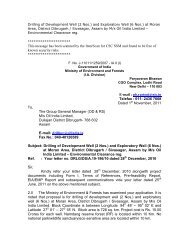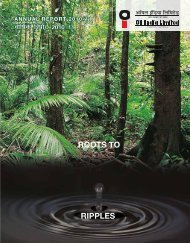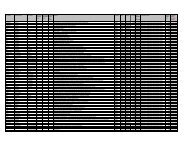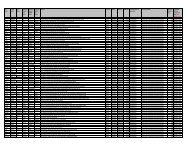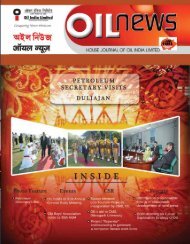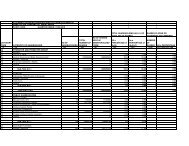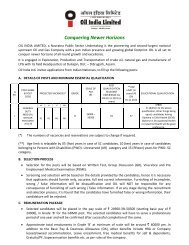2005 - Oil India Limited
2005 - Oil India Limited
2005 - Oil India Limited
Create successful ePaper yourself
Turn your PDF publications into a flip-book with our unique Google optimized e-Paper software.
OIL beyond territorial barriers<br />
petroleum products including pricing, distribution to bulk<br />
consumers and retailing .<br />
Natural Gas Value Chain<br />
Unlike crude oil, natural gas could be sold in the retail<br />
market directly. Natural gas is also extensively used for<br />
generation of electricity. Natural gas value chain comprises<br />
of transportation (by pipeline or as LNG), marketing as gas,<br />
and generation / sale of electricity. Besides these uses as<br />
energy, natural gas value chain includes the fractionation<br />
of natural gas into various components like methane,<br />
ethane, LPG, natural gas liquids, etc. Some of these<br />
fractions are valuable and preferred raw materials for the<br />
petrochemicals value chain.<br />
Chemicals Value Chain<br />
Chemicals value chain starts with processing of naphtha<br />
obtained as a crude oil refinery product and selected<br />
fractions of natural gas for the production of various value<br />
added chemicals. The major petrochemicals value subchains<br />
relate to plastics, fabrics and organic chemicals.<br />
Each of these sub-chains are long with several branches<br />
and will not be discussed here.<br />
INTERNATIONAL OIL MAJORS<br />
Most of the internationally competitive major oil<br />
companies are vertically integrated with business<br />
interests along the entire petroleum value chain. Break-up<br />
of gross revenue and earnings of an oil major for two years<br />
during the relatively stable price regime of 1990s are<br />
shown below as an illustration.<br />
Year Business Sales Earnings Capital<br />
Segment<br />
Investment<br />
X<br />
Y<br />
Up-stream<br />
(including<br />
Natural Gas) 6.9 % 66.3 % 53.6 %<br />
Down-stream 79.2 % 14.9 % 24.2 %<br />
Chemicals 13.9 % 18.8 % 22.1 %<br />
Up-stream<br />
(including<br />
Natural Gas) 6.0 % 42.6 % 49.4 %<br />
Down-stream 79.4 % 33.6 % 36.8 %<br />
Chemicals 14.6 % 23.8 % 13.8 %<br />
An analysis of the information tabulated above would<br />
make it clear that sales revenue is much higher in the<br />
down-stream business, while profit is much higher in the<br />
up-stream business<br />
It would be of interest to note here that capital investment<br />
is comparatively high in the up-stream business.<br />
However, the Return On Capital (ROC) is also much<br />
higher in the case of the up-stream business as would be<br />
evident from the following example:<br />
Business Capital Return On<br />
Segment Employed Capital<br />
Up-stream 45 % 17 %<br />
Down-stream 35 % 6 %<br />
Chemicals 20 % 10 %<br />
UP-STREAM INDEPENDENTS<br />
The up-stream business is far more risky. In addition to<br />
uncertainties with regard to underground reserves and<br />
production rates, E & P business is heavily dependent upon<br />
crude oil price, which fluctuates widely and does not<br />
follow typical market dynamics of demand - supply. Some<br />
of the factors contributing to price volatility of crude oil are<br />
areas of excess production being away from the areas of<br />
large consumption, excessive dependance on the OPEC<br />
countries for supply, concentration of surplus availability in<br />
localized areas, wars / hostilities and other potential<br />
political changes / uncertainties in major oil producing<br />
areas like west Asia. Of late, sharp increase in the demand<br />
for oil in the rapidly growing large economies of China and<br />
<strong>India</strong> has greatly reduced the surplus availability of crude<br />
oil. As a result, temporary shut-down of producing fields<br />
even outside the OPEC results in a near panic situation<br />
resulting in over-heating of the market.<br />
Asset values of an E & P company should ideally include<br />
all the assets that the company owns. Typically, these<br />
would include the producing fields, fields under<br />
development, discoveries under appraisal, new<br />
discoveries and exploration acreage. From the angle of<br />
risk and cash flow potential, the asset values may be<br />
classified as core values and upside potentials. The core<br />
values include producing fields and fields under<br />
development. Upside potential is far less certain and<br />
3




